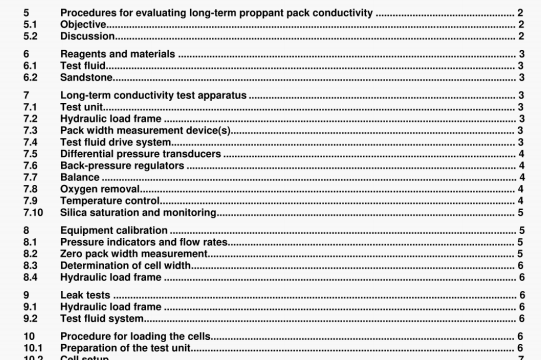BS EN ISO 13503-5 pdf download – BS EN ISO 13503-5 pdf Petroleum and naturalgas industries —— Completion fluids andmaterials —— Part 5: Procedures for measuring thelong-term conductivity of proppants.
7.6 Back.pressure regulators
The back-pressure regulator shall be capable of maintaining a pressure of 2.07 MPa to 3.45 UPa (300 psi to 500 psI). The stress applIed 10 the cells shall take into account the back.pressure, For example. it the back- pressure is 3,45 MPa (500 psi), then the applied stress shall be 3,45 MPa (500 psi) greater to take into account the pressure exerted outward from the pistons.
7.7 Balance
The balance shall be capable of accommodating a minimum capacity of lOOg with a precision greater than
0,01 9.
7.8 Oxygen removal
The conductivity test fluid shall have the oxygen content reduced to simulate reservoir fluids and to minimize corrosion of test equment, De-oxygenation can be accomplished with a two-reservoir system fOr the fluid. The first reservoir holds fluid for oxygen removal. This is connected to nitrogen gas that is bubbled through the fluid at low pressure below 103 kPa (15 psi) and atlow rate. The nitrogen supply is first passed through an oxygenimoisture trap such as Agilent Model 0T3-4 that has an etfloency to remove oxygen to less than 15 ig/l. An equivalent system can be made; this system allows nitrogen to pass through heated copper shavings at 370 C (698 F). where the copper reacts with the trace amounts of oxygen in the syst forming copper oxide. An indicating trap, such as the oxygen trap by Chron, Tech. Inc. part N 1OT-4-HP , after the oxygen-removal process allows for visual confirmation that oxygen has been removed. W1,en the visual indicating trap is oxygen-saturated, both traps shall be replaced to maintain the efficiency of oxygen removal. The second reservoir holds the oxygen-free fluid; this is the supply reservoir for the pumping system.
All fluids m each reservoir are held in sealed, inert-gas pressurized containers to eliminate oxygen contamination from the air.
7.9 Temperature control
The test cell and proppant pack shall be maintained at the desired te,vWerature ± 1 C (±3 CF). The temperature for the test conditions is measured in the temperature port of the conductivity cell (Fi9ure Cl). This temperature is used to determine the fluid viscosity from Table C.1. The thermocouple assembly is split into a temperature-control device and a data-acquisition system or equivalent. The temperature control devices shall be programmable PlO controllers arid capable of self-tuning for different temperature conditions and flow rates.
A temperature of 121 °C (250 F) is employed in the test for ceramics and resin-coated proppants and 66 °C (150 F) for natLirally occurring sands. The temperature for the silica-saturation vessel (see Annex ) should be 11 C (20 F) above testing temperature of 66 C (150 F) for naturally occurring sands. Sand 20 C (35 °F) above 121 °C (250 F) is used for resin-coated and ceramic proppants to ensure that the fluid is saturated with silica prior to reaching the cell. Care shall be taken to ensure that ti-ia fluid arriving to the cell is at the appropriate temperature. Tests using other fluids or temperatures can be of value In evaluating proppant pack conductivity,
10.1.2.4 Place the top piston in the conductivity cell. Place the cell in the press and apply between
0,3 MPa (50 psi) and I UPa (150 psi) closure. Attach the heat strçe, and heat to 66 C (150 F) for one hour.
Remove core slabs. Trim all excess RTV ott the face of the preset core and be certain there are no chips or cracks in the core.
NOTE It no heat is applied, the RTV cures in about 24 h.
10.2 Cell setup
10.2.1 Setting bottom piston
The cells are stacked in the same order in whiCh the zero pack widths were measured (see 8.2.2). Blocks can be used to hold the cell in place so the sandstone core is approximately 0.02 mm (0.000 6 in) or just below the differential pressure ports. This can be achieved by placing one metal shim and sandstone core with no RTV on piston in the cell. When the height of the piston is approximately in the right position, tighten the set screws to secure the position of the cell, and remove the shim and sandstone core to instal the square nng. Protect the integrity of the square nng.
10.2.2 SettIng the bottom core
Measure the metal shim and record its thickness Differences between the shim thicknesses from 82.2.1 shall be taken in account. Place the shim in the bottom of the cell. Apply a thin film of RTV around the edge on the selected core (see 8.22.1). With a spatula. smooth the RTV to even the surface without getting RTV on the faces of the core. Remove the bottom tape from the core and slide the core into the cell until reaching the shim. Apply RTV around the edge of the core•tocell interface and push RTV into the crack using a cotton swab Remove the excess RTV and top tape.
BS EN ISO 13503-5 pdf download – BS EN ISO 13503-5 pdf Petroleum and naturalgas industries —— Completion fluids andmaterials —— Part 5: Procedures for measuring thelong-term conductivity of proppants
